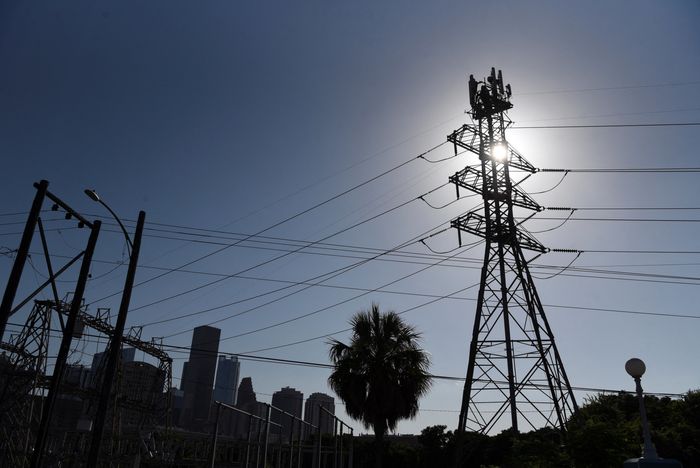Electric supplies from renewable energy, hydropower, and batteries bolster vulnerable parts.
July 23, 2023 5:30 am ET
Texas has long been particularly vulnerable to electricity supply shortages.
A punishing heat wave is pushing electricity demand to record levels in some parts of the U.S., but the power grid has held up because of a combination of luck and new energy supplies.
Last summer, grid operators in Texas and California narrowly avoided the need for rolling blackouts as electricity reserves in two of the country’s biggest power markets dwindled. Residents were asked to use less power as temperatures blazed.
Since then, California has benefited from a surge in hydroelectric generation after an unusually wet winter and spring, as well as a build-out of large-scale batteries that discharge power in the evening as solar generation declines. Texas, meanwhile, has added a substantial number of solar farms that are supplying power during the hottest parts of the day and helping to offset unexpected mechanical problems with some coal-fired and gas-fired plants.
“The grid seems to be holding up OK, and it proves we need all resources for all times of year and all types of weather,” said Bernard McNamee, a former member of the Federal Energy Regulatory Commission. “Just because one resource is performing well today doesn’t mean it’s going to perform as well tomorrow.”
The grid is likely to face sustained stress for the rest of summer as high temperatures are expected to persist or worsen in many parts of the country, pushing utility customers to blast air conditioners.
Extreme heat has blanketed other parts of the West and South, with temperatures soaring above 110 degrees Fahrenheit in Phoenix for more than 20 consecutive days. Arizona Public Service, which provides electricity for much of the state, saw a record 8,191 megawatts of electricity demand on July 15. The company offered customers energy-saving tips to reduce costs and support grid reliability.
Texas and California have historically been most vulnerable to electricity supply shortages during exceptional heat waves because each has seen a rapid shift in generation sources as a result of market competition and, in California’s case, state policy promoting the build-out of renewables. Most other parts of the West and South don’t operate competitive electricity markets, and regulators have generally allowed utilities to build more than enough power plants to meet demand and recoup construction costs from customers.
In deregulated electricity markets, power plants are typically built and operated by companies that compete to sell power at the lowest cost. They are paid for the power their plants produce and, in most markets, given some form of additional payment for being ready to perform to ensure the market has sufficient resources.
In California, power-supply scares have occurred during the past few summers as the state replaces gas-fired power plants—which can produce power at all hours—with solar farms, and, to a lesser extent, wind farms whose outputs vary by time and season. A California law passed in 2018 requires the state to decarbonize its power grid by 2045.
California last experienced rolling blackouts in August 2020 during a heat wave across the West that limited the state’s ability to import power from elsewhere in the region, something it has historically had to do in times of need. A protracted drought constrained hydroelectric output, adding to the challenge of finding enough power to meet evening demand as solar generation ramped down.
This summer, though, hydroelectric power is more abundant than it has been in years following a winter that replenished reservoirs and created record snowpack that will melt throughout the summer. Severin Borenstein, an energy economist at the University of California, Berkeley, has said the extra capacity might help reduce the need for imports if a severe West-wide heat wave occurs later in the season.
“When that happens, the question is how much imports are we going to be able to get?” Borenstein said. “How much will show up, unfortunately, is just always a crapshoot.”
California has also brought about 5,600 megawatts of battery storage capacity online as of this month, up from 500 megawatts three years ago. The batteries charge during the day and discharge primarily in the evening hours.
A megawatt of electricity provides roughly enough power to meet demand for 750 homes, according to the California Independent System Operator, which operates the state’s power grid.
Mark Rothleder, CAISO’s chief operating officer, said the California grid has so far avoided major strain in part because it hasn’t been extremely hot along the coast where many of the state’s biggest cities are. A heat wave similar to what occurred across the West last September, which resulted in emergency calls for conservation, could cause challenges even with more abundant supplies, he said.
“I’m cautiously optimistic, but we haven’t yet had the full test,” Rothleder said. “We may have to go into some of the emergency or strategic reserves if we repeat what we had last year.”
The Electric Reliability Council of Texas, which operates the state’s power grid, last month asked residents to voluntarily conserve electricity but hasn’t done so since then even as power demand shatters records. The grid operator recorded 82,592 megawatts of demand this past week, a new high.
Texas residents and lawmakers have been concerned about the state of the power grid since a freak winter storm in February 2021 that caused power plants of all kinds to trip offline. Demand threatened to exceed available supply, forcing ERCOT to call for dayslong blackouts to maintain balance. Hundreds of people died in the cold.
Since then, ERCOT has been calling on some of the state’s oldest and priciest power plants to run more often than usual for fear of having short supplies. That has put a strain on the plants and increased the likelihood of mechanical problems, operators say.
According to data tracker Grid Status, conventional power plants supplying more than 6,000 megawatts tripped offline at many points during a recent week, more than the roughly 5,000 megawatts the grid operator typically expects at this time of year.
Renewable generation has offset those losses. This summer, the ERCOT system is operating with more than 17,700 megawatts of solar capacity, more than double the amount installed at this time last year. Texas also has just over 37,700 megawatts of wind capacity, more than any other state.
Together, wind and solar farms represent nearly 40% of installed capacity in Texas. Natural gas, long the state’s dominant power source, accounts for about 42%.
“The No. 1 thing is having so much solar on the system performing at the peak,” said Doug Lewin, president of Stoic Energy Consulting and author of the Texas Energy and Power Newsletter. “We have 12 or 13 gigawatts working like clockwork during these summer heat waves.”
https://www.wsj.com/articles/the-u-s-power-grid-withstands-the-heat-so-far-30e70a9c?st=ig5ztdjbs88p2t0


